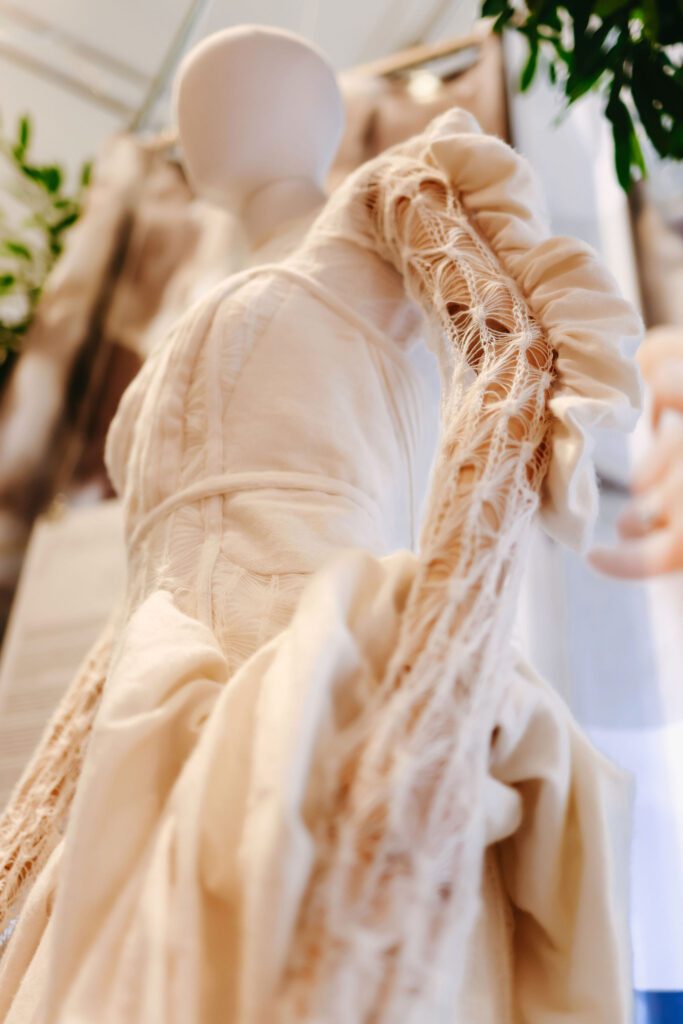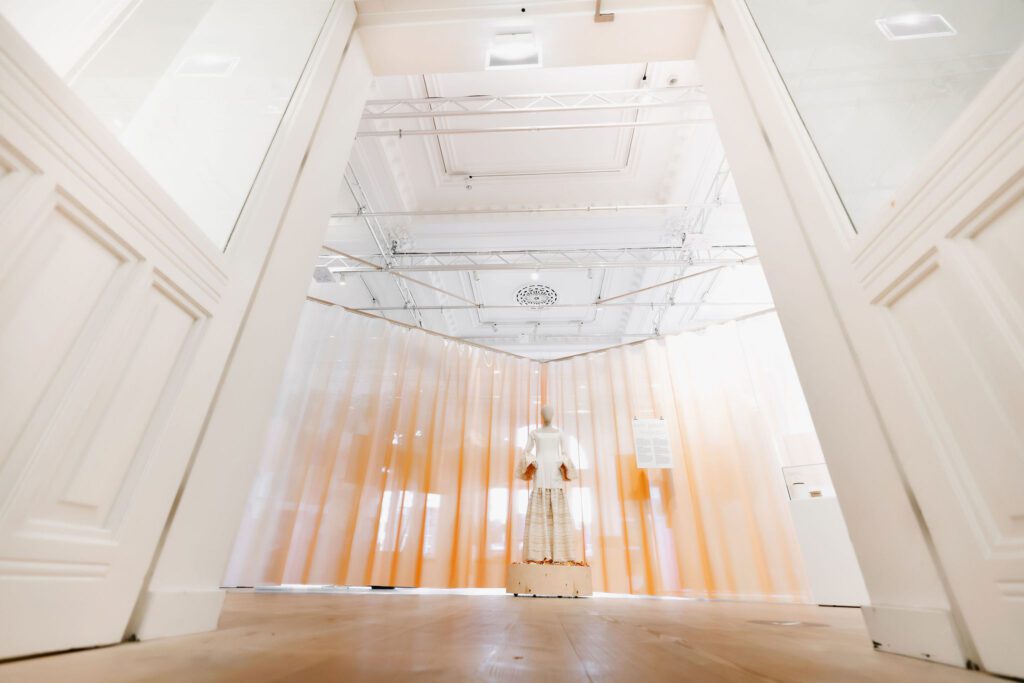GROW: The World of Biomaterials (2021-22)
Fruit skin fabric, mushroom ‘leather’, spider-silk, dye made by bacteria and algae; “GROW”, the exhibition from the Fashion for Good Museum in Amsterdam explored the biomaterials and cutting-edge innovations that shaped the sustainable future of fashion.
GROW (6 April 2021 – 12 May 2022)
Nature is often a source of inspiration for fashion but it is also being depleted by the current fashion industry. The system behind the fashion industry must change and become circular: new, more sustainable materials are an important part of this change. These are in full development but are often unknown to the general public or not yet available in stores. The world of biomaterials is complex and full of technical terminology. In fact, the definition of ‘biomaterials’ is not generally understood, which leads to misuse, misinformation and greenwashing.
To shed light on these developments, Fashion for Good and Biofabricate, an organisation specialising in all things biomaterials, wrote the report “Understanding Bio Material Innovations: a primer for the fashion industry”. It was targeted at fashion industry professionals to provide a clearer understanding of what biomaterials are, how they are made and how they can be used in fashion. In addition, the museum took part in the EU Horizon 2020 project Allthings.bioPRO, developing a serious game to encourage EU citizens to engage with the bioeconomy. As part of this three-year project and drawing on the findings of the report, the Fashion for Good Museum created GROW, an exhibition in two parts which was on display at the Museum between 6th April 2021 and 12th May 2022 and went on a European tour in 2023.
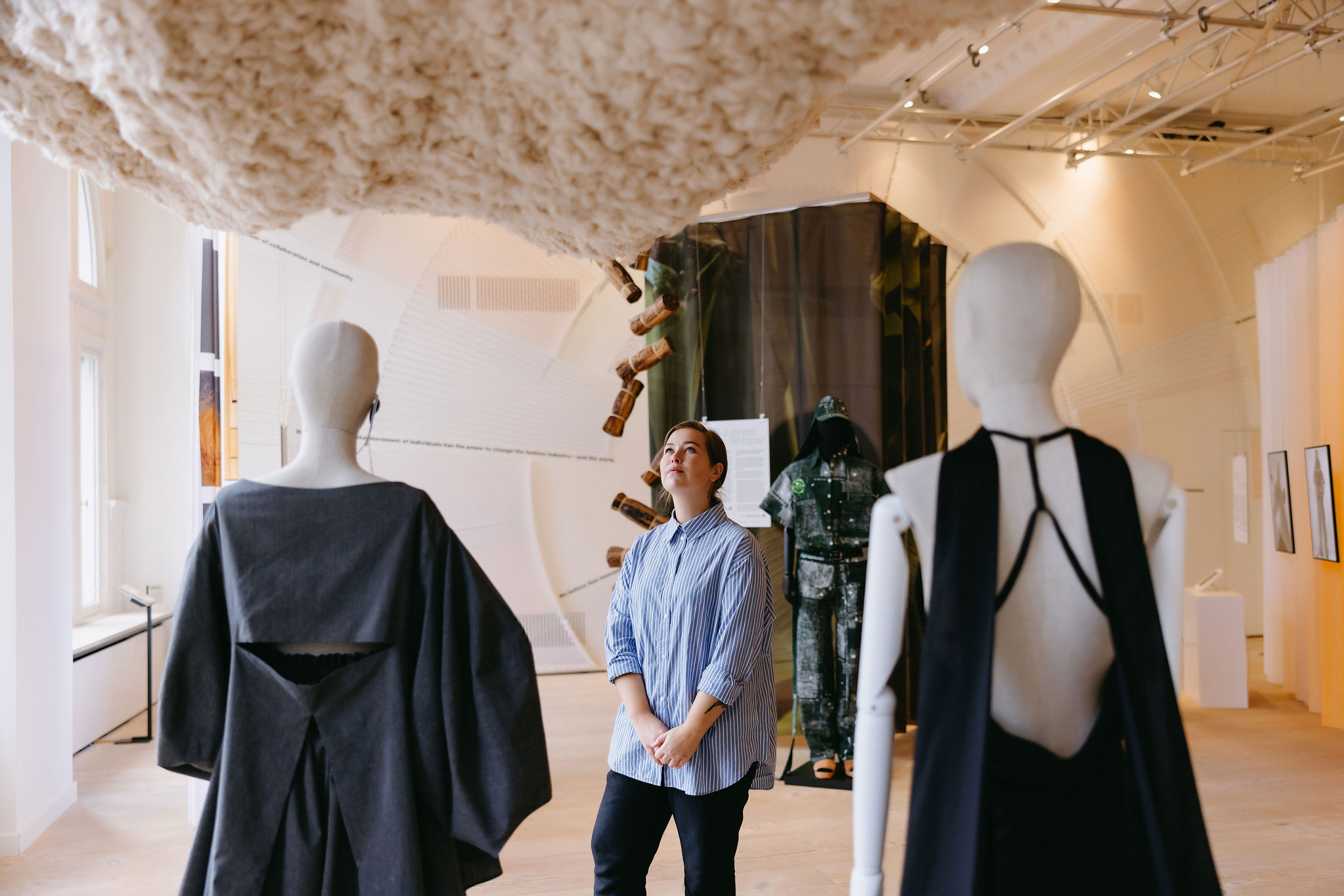
Content
The first part of the exhibition, GROW: The World of Biomaterials, set the scene, introducing the terminology around biomaterials and the importance of the development of (new) biomaterials in the fashion industry. It focussed on biomaterial innovations from Colorifix, Spiber, Spinnova, MIRUM (Natural Fiber Welding), Green Whisper, Bioglitz, Flocus and Orange Fiber, among others. To show how innovative biomaterial textiles and leather alternatives can be used in the fashion industry, and to enable young designers to work with new biomaterials, the Museum launched the “GROW Talent” programme.
An industry-expert jury selected six young creatives including designers, a writer and a photographer, to help co-create the second part of the exhibition, titled GROW: The Future of Fashion. This second part brought the innovations presented in the first part to life, and made the topic of biomaterials and sustainability in fashion more accessible to young creatives through the Talent programme. Dutch-based designers Huong Nguyen, Frederieke Broekgaarden, Eva Sonneveld and Charlotte Bakkenes used textile made from banana plant stems, leather alternatives from coconut husks and cork powder and more, to create four unique looks.
Through the programme, these designers learned from each other and from industry professionals, creating garments and accessories with cutting-edge materials. This benefited both the designers, who learned how these new materials perform and what biomaterials are out there, and the innovators who supplied the materials, as they learned how their materials may be used and what applications are needed. The four looks were displayed alongside raw materials illustrating the origins of the garments, connecting science, fashion and innovation in the exhibition.
In addition, we commissioned established fashion designer and illustrator Karim Adduchi to create a gown made with orange peel “silk”, and designer Sjaak Hullekes of Hul Le Kes to create two looks made of vintage linen, dyed with innovative pigment, and showcased an innovative leather dress by Iris van Herpen. GROW was further supported by a campaign photographed by Christian Mpamo and copywriting by Zainab Goelaman, also selected by the industry jury of the GROW Talent project. Together, the showcased innovators and designers made the future of fashion tangible for visitors, with the intent to inspire them and introduce them to textiles and materials that have never been shown in a museum before.
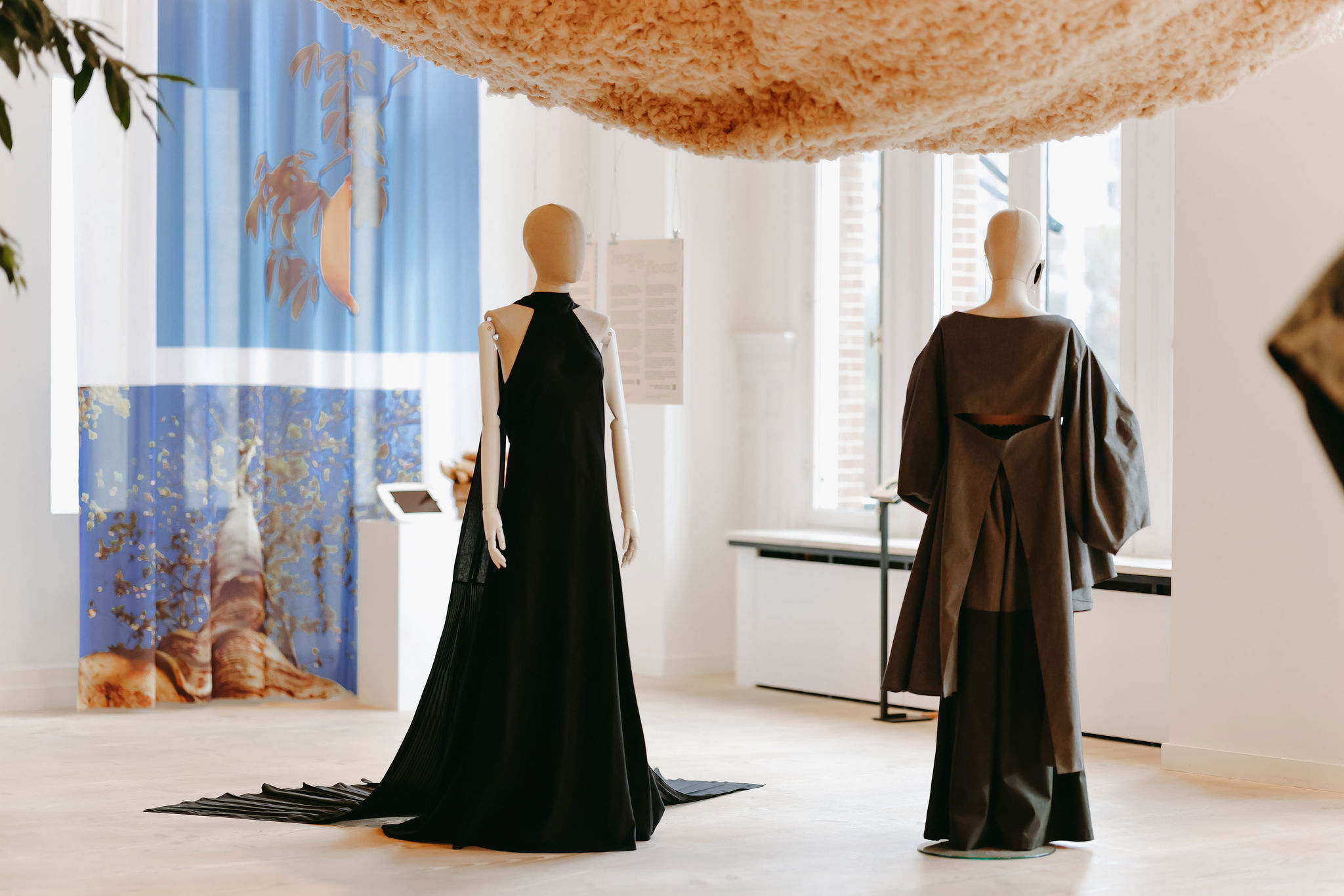
Exhibition design
The exhibition design was developed by Studio Harm Rensink, with a brief to use the most sustainable material options and to create a modular and flexible mechanism for display. Studio Harm Rensink designed a lightweight structure using recycled polyester curtains printed with visual material in order to create stunning installations that guided the visitors’ path through the museum. Combining display strategies from traditional fashion exhibitions and science museums, the exhibition included garments placed on dressmaker mannequins at eye-level with the visitor, as well as multiple interactive stations and elements which could be freely touched.
The see-through curtains let in plenty of natural light and the exhibition contained trees and raw materials such as banana leaves and kapok pods, giving the museum and garden-like feeling. By including playful elements such as a biodegradable glitter station, an Instagram filter and a ‘Guess The Biomaterial’ game, the exhibition offered a playful and multisensory experience and encouraged visitors to learn by touching and smelling, as well as traditional audiovisual means.
Travelling exhibition and Allthings.bioPRO
After having been displayed at the Fashion for Good Museum, GROW travelled as a pop-up exhibition to schools across Europe to inspire the next generation of fashion designers and consumers. In the course of 2023, it could be seen at Vejle Tekniske Gymnasium in Denmark in February, the Metropolitan University in Budapest in March and VORN Hub in Berlin as part of Berlin Fashion Week in July. As part of the travelling exhibition, the Museum delivered public programmes and tours aimed at students, introducing them to the bioeconomy and inviting them to become familiar with biobased textiles.
In addition, exhibition visitors had the chance to test the serious game MissionBioHero and the accompanying app LabelBioHero developed by Allthings.bioPRO. Allthings.bioPRO was designed to address a major gap in encouraging citizen engagement and to create a deeper understanding of the bioeconomy. To achieve this, citizens and other stakeholders co-created a serious game (educational game) and a smartphone app spanning four different missions: food packaging, fashion and textiles, kids and schools and jobs and careers.
The exhibition was made possible with the generous support of Amsterdams Fonds voor de Kunst and the Bio-based Industries Joint Undertaking (JU) under the European Union’s Horizon 2020 research and innovation programme.
![]()

Other Education Programmes

Museum Legacy
On this page you find our Museum legacy document, celebrating the incredible journey of the Fashion for Good Museum. As the Museum doors have closed on June 5th, 2024, we want to extend our deepest gratitude to you, our amazing community of conscious consumers and visitors.
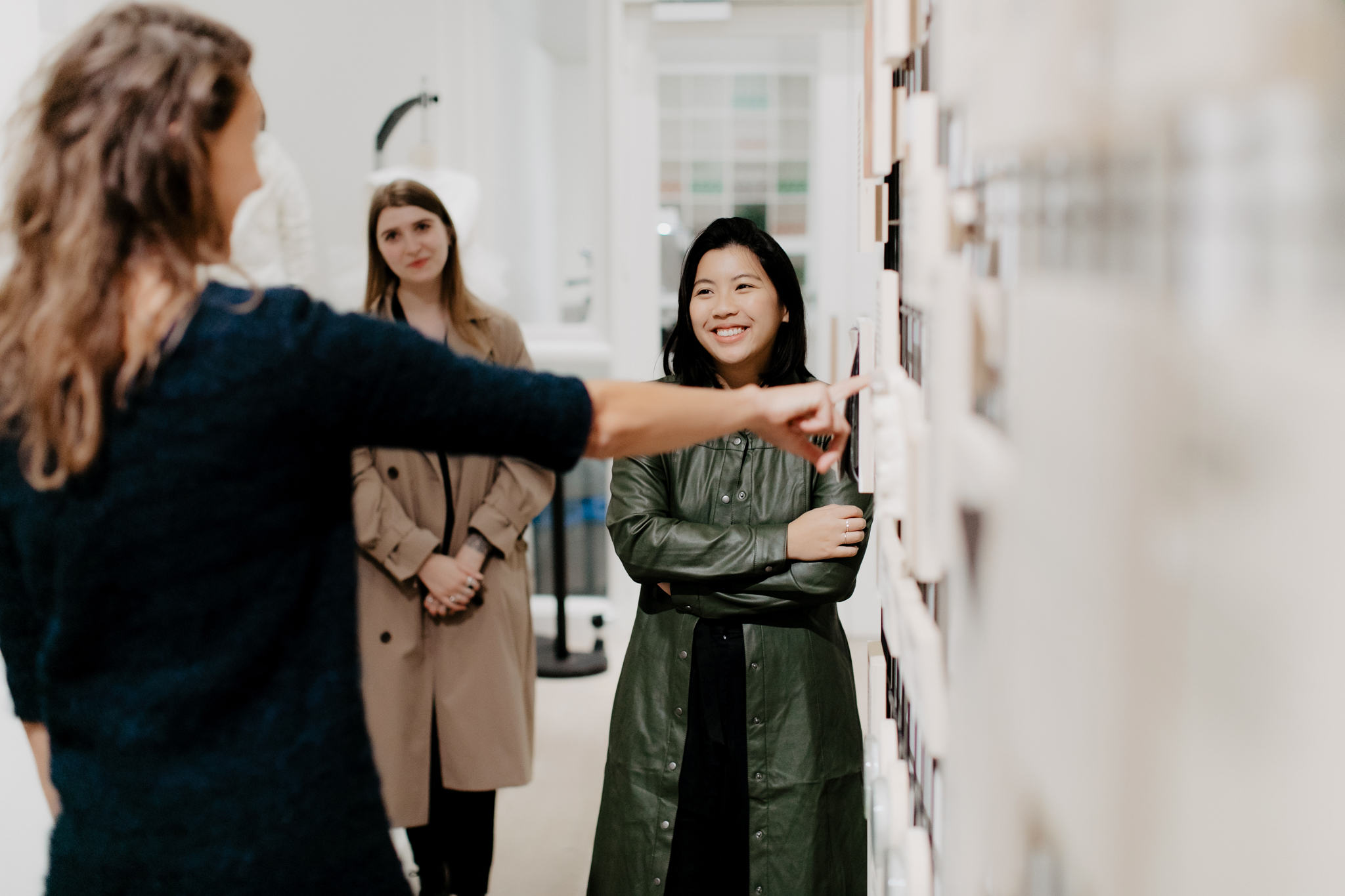
Educational Resources
Change starts with the new generation of industry professionals, but also with the individual consumer. Our educational programmes and tools help younger generations understand their role in the narrative, giving them the knowledge and tools to take action and change fashion for the better.

Past Exhibitions
Discover some of our past exhibitions on this page. Read up on our approaches to sustainable exhibition development and discover the artists and designers we featured in our exhibitions GROW, Knowing Cotton Otherwise and What Goes Around Comes Around.

